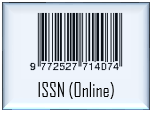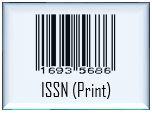FORMULATION AND CARACTERIZATION OF QUERCETIN NIOSOME WITH CONCENTRATION VARIATIONS OF SPAN 20 SURFACTANT
(1) PGRI Madiun University
(2) Maulana Malik Ibrahim State Islamic University
(3) Maulana Malik Ibrahim State Islamic University
(*) Corresponding Author
Abstract
Quercetin has low solubility, absorption and bioavailability which limits its practical use as a drug or supplement. Therefore, it is important to formulate a quercetin niosome system with various concentrations of span 20 as a surfactant. This investigation aimed to formulate and analyse a quercetin niosome preparation with span 20 variations to provide optimal quercetin solubility. Niosomes were prepared using various concentrations of span 20. In the present study, the quercetin niosome used the reverse phase evaporation (RPE) method. Quercetin niosome is characterised by its organoleptic properties, pH value, particle morphology comprising the particle shape and size, and encapsulation efficiency. Organoleptic observations of the quercetin niosome included a yellow colour, distinctive quercetin odour and thick consistency for all formulas. The pH remained within the physiological pH range of skin. Quercetin niosome morphology was close to spherical while the niosome particle size results were 2.13 µm (F1), 2.99 µm (F2) and 3.31 µm (F3). The quercetin niosome encapsulation efficiency results were 81.86 ± 0.47% (F1), 84.02 ± 0.26% (F2) and 88.24 ± 0.10% (F3). Quercetin niosome were successfully prepared using multiple span 20 concentrations below the cholesterol concentration characterised by the measurement results of organoleptic, pH, particle morphology and encapsulation efficiency.
Keywords
Full Text:
PDFReferences
Abdelbary, G., El-gendy, N., 2008. Niosome-Encapsulated Gentamicin for Ophthalmic Controlled Delivery. AAPS PharmSciTech 9, 740–747. https://doi.org/10.1208/s12249-008-9105-1
Al Qtaish, N., Gallego, I., Villate-Beitia, I., Sainz-Ramos, M., López-Méndez, T.B., Grijalvo, S., Eritja, R., Soto-Sánchez, C., Martínez-Navarrete, G., Fernández, E., Puras, G., Pedraz, J.L., 2020. Niosome-based Approach for in situ Gene Delivery to Retina and Brain Cortex as Immune-privileged Tissues. Pharmaceutics, 12, 1–29. https://doi.org/10.3390/pharmaceutics12030198
Barani, M., Mirzaei, M., Torkzadeh-Mahani, M., Nematollahi, M.H., 2018. Lawsone-loaded Niosome and Its Antitumor Activity in MCF-7 Breast Cancer Cell Line: A Nano-herbal Treatment for Cancer. DARU, J. Pharm. Sci, 26, 11–17. https://doi.org/10.1007/s40199-018-0207-3
Barani, M., Nematollahi, M.H., Zaboli, M., Mirzaei, M., Torkzadeh-Mahani, M., Pardakhty, A., Karam, G.A., 2019. In silico and in vitro Study of Magnetic Niosomes for Gene Delivery: The Effect of Ergosterol and Cholesterol. Mater. Sci. Eng. C 94, 234–246. https://doi.org/10.1016/j.msec.2018.09.026
Berlepsch, H. V., Thota, B.N.S., Wyszogrodzka, M., De Carlo, S., Haag, R., Böttcher, C., 2018. Controlled Self-assembly of Stomatosomes by Use of Single-component Fluorinated Dendritic Amphiphiles. Soft Matter, 14, 5256–5269. https://doi.org/10.1039/c8sm00243f
Cerqueira-Coutinho, C., dos Santos, E.P., Mansur, C.R.E., 2016. Niosomes as Nano-Delivery Systems in the Pharmaceutical Field. Crit. Rev. Ther. Drug Carr. Syst. 33, 195–212. https://doi.org/10.1615/CritRevTherDrugCarrierSyst.201601616
Chen, S., Hanning, S., Falconer, J., Locke, M., Wen, J., 2019. Recent Advances in Non-ionic Surfactant Vesicles (niosomes): Fabrication, Characterization, Pharmaceutical and Cosmetic Applications. Eur. J. Pharm. Biopharm. 144, 18–39. https://doi.org/10.1016/j.ejpb.2019.08.015
Chondrogianni, N., Kapeta, S., Chinou, I., Vassilatou, K., Papassideri, I., Gonos, E.S., 2010. Anti-ageing and rejuvenating effects of quercetin. Exp. Gerontol, 45, 763–771. https://doi.org/10.1016/j.exger.2010.07.001
Chopra, M., Fitzsimons, P.E.E., Strain, J.J., Thurnham, D.I., Howard, A.N., 2000. Nonalcoholic Red Wine Extract and Quercetin Inhibit LDL Oxidation without Affecting Plasma Antioxidant Vitamin and Carotenoid Concentrations. Clin. Chem. 46, 1162–1170.
D’Andrea, G., 2015. Quercetin: A Flavonol with Multifaceted Therapeutic applications? Fitoterapia, 106, 256–271. https://doi.org/10.1016/j.fitote.2015.09.018
Dan, N., 2017. Core–shell Drug Carriers: Liposomes, Polymersomes, and Niosomes, in: Nanostructures for Drug Delivery. Elsevier, 63–105. https://doi.org/10.1016/B978-0-323-46143-6.00002-6
Date, A.A., Nagarsenker, M.S., Patere, S., Dhawan, V., Gude, R.P., Hassan, P.A., Aswal, V., Steiniger, F., Thamm, J., Fahr, A., 2011. Lecithin-Based Novel Cationic Nanocarriers (Leciplex) II: Improving Therapeutic Efficacy of Quercetin on Oral Administration. Mol. Pharm, 8, 716–726. https://doi.org/10.1021/mp100305h
Elmowafy, E., El-Derany, M.O., Biondo, F., Tiboni, M., Casettari, L., Soliman, M.E., 2020. Quercetin Loaded Monolaurate Sugar Esters-Based Niosomes: Sustained Release and Mutual Antioxidant—Hepatoprotective Interplay. Pharmaceutics 12, 143. https://doi.org/10.3390/pharmaceutics12020143
Erlund, I., Kosonen, T., Alfthan, G., Mäenpää, J., Perttunen, K., Kenraali, J., Parantainen, J., Aro, A., 2000. Pharmacokinetics of Quercetin from Quercetin Aglycone and Rutin in Healthy Volunteers. Eur. J. Clin. Pharmacol, 56, 545–553. https://doi.org/10.1007/s002280000197
Gang, W., Gang, W., Wang, J., Yang, G., Du, S., Li, D., Li, R., Chen, J., Zeng Nan, Feng, J., Yuan, S., 2012. Effects of Quercetin Nanoliposomes on C6 Glioma Cells through Induction of Type III Programmed Cell Death. Int. J. Nanomedicine, 271. https://doi.org/10.2147/IJN.S26935
Ge, X., Wei, M., He, S., Yuan, W.E., 2019. Advances of Non-ionic Surfactant Vesicles (Niosomes) and Their Application in Drug Delivery. Pharmaceutics, 11, 1–16. https://doi.org/10.3390/pharmaceutics11020055
Gilani, S.J., Imam, S.S., Ahmed, A., Chauhan, S., Mirza, M.A., Taleuzzaman, M., 2019. Formulation and Evaluation of Thymoquinone Niosomes: Application of Developed and Validated RP-HPLC Method in Delivery System. Drug Dev. Ind. Pharm. 45, 1799–1806. https://doi.org/10.1080/03639045.2019.1660366
Goniotaki, M., Hatziantoniou, S., Dimas, K., Wagner, M., Demetzos, C., 2004. Encapsulation of Naturally Occurring Flavonoids into Liposomes: Physicochemical Properties and Biological Activity against Human Cancer Cell Lines. J. Pharm. Pharmacol, 56, 1217–1224. https://doi.org/10.1211/0022357044382
Gonta, M., Sirbu, E., Robu, S., Gonta, A., Mocanu, L., 2020. Functionalization of flavonoids (quercetin) to chitosan matrix and determination of antioxidant activity of obtained bio-composites, in: IFMBE Proceedings. pp. 355–359. https://doi.org/10.1007/978-3-030-31866-6_66
Guo, D., Wu, C., Li, J., Guo, A., Li, Q., Jiang, H., Chen, B., Wang, X., 2009. Synergistic Effect of Functionalized Nickel Nanoparticles and Quercetin on inhibition of the SMMC-7721 cells Proliferation. Nanoscale Res. Lett. 4, 1395–1402. https://doi.org/10.1007/s11671-009-9411-x
Han, Q., Yang, R., Li, J., Liang, W., Zhang, Y., Dong, M., Besenbacher, F., Wang, C., 2012. Enhancement of Biological Activities of Nanostructured Hydrophobic Drug Species. Nanoscale 4, 2078. https://doi.org/10.1039/c2nr12013e
Jain, S., Vyas, S.P., 2006. Mannosylated Niosomes as Adjuvant-Carrier System for Oral Mucosal Immunization. J. Liposome Res. 16, 331–345. https://doi.org/10.1080/08982100600992302
Khoee, S., Rahmatolahzadeh, R., 2012. Synthesis and Characterization of pH-responsive and folated nanoparticles based on Self-assembled Brush-like PLGA/PEG/AEMA Copolymer with Targeted Cancer Therapy Properties: A Comprehensive Kinetic Study. Eur. J. Med. Chem. 50, 416–427. https://doi.org/10.1016/j.ejmech.2012.02.027
Kumar, N., Goindi, S., 2014. Statistically Designed Nonionic Surfactant Vesicles for Dermal Delivery of Itraconazole: Characterization and in vivo Evaluation Using a Standardized Tinea pedis Infection Model. Int. J. Pharm. 472, 224–240. https://doi.org/10.1016/j.ijpharm.2014.06.030
Lesjak, M., 2018. Antioxidant and Anti-inflammatory Activities of Quercetin and Its Derivatives. J. Funct. Foods 40, 68–75. https://doi.org/10.1016/j.jff.2017.10.047
Lesjak, M., Beara, I., Simin, N., Pintać, D., Majkić, T., Bekvalac, K., Orčić, D., Mimica-Dukić, N., 2018. Antioxidant and Anti-inflammatory Activities of Quercetin and Its Derivatives. J. Funct. Foods 40, 68–75. https://doi.org/10.1016/j.jff.2017.10.047
Lin, J., Zhou, W., 2018. Role of Quercetin in the Physicochemical Properties, Antioxidant and Antiglycation Activities of Bread. J. Funct. Foods 40, 299–306. https://doi.org/10.1016/j.jff.2017.11.018
Lu, B., Huang, Y., Chen, Z., Ye, J., Xu, H., Chen, W., Long, X., 2019. Niosomal Nanocarriers for Enhanced Skin Delivery of Quercetin with Functions of Anti-tyrosinase and Antioxidant. Molecules, 24. https://doi.org/10.3390/molecules24122322
Mali, N., Darandale, S., Vavia, P., 2013. Niosomes as a Vesicular Carrier for Topical Administration of Minoxidil: Formulation and in vitro Assessment. Drug Deliv. Transl. Res. 3, 587–592. https://doi.org/10.1007/s13346-012-0083-1
Manosroi, A., Wongtrakul, P., Manosroi, J., Sakai, H., Sugawara, F., Yuasa, M., Abe, M., 2003. Characterization of Vesicles Prepared with Various Non-ionic Surfactants Mixed with Cholesterol. Colloids Surfaces B Biointerfaces, 30, 129–138. https://doi.org/10.1016/S0927-7765(03)00080-8
Mehta, S.K., Jindal, N., Kaur, G., 2011. Quantitative Investigation, Stability and in vitro Release Studies of Anti-TB Drugs in Triton Niosomes. Colloids Surfaces B Biointerfaces, 87, 173–179. https://doi.org/10.1016/j.colsurfb.2011.05.018
Moghassemi, S., Hadjizadeh, A., 2014. Nano-niosomes as Nanoscale Drug Delivery Systems: An Illustrated Review. J. Control. Release, 185, 22–36. https://doi.org/10.1016/j.jconrel.2014.04.015
Pal, A., Tripathi, A., 2020a. Quercetin Inhibits Carbapenemase and Efflux Pump Activities among Carbapenem‐Resistant Gram‐Negative Bacteria. APMIS 128, 251–259. https://doi.org/10.1111/apm.13015
Pal, A., Tripathi, A., 2020b. Demonstration of Bactericidal and Synergistic Activity of Quercetin with Meropenem among Pathogenic Carbapenem Resistant Escherichia coli and Klebsiella pneumoniae. Microb. Pathog. 143, 104120. https://doi.org/10.1016/j.micpath.2020.104120
Pal, A., Tripathi, A., 2019. Quercetin Potentiates Meropenem Activity among Pathogenic Carbapenem‐Resistant Pseudomonas aeruginosa and Acinetobacter baumannii. J. Appl. Microbiol. 127, 1038–1047. https://doi.org/10.1111/jam.14388
Patel, R. V., Mistry, B.M., Shinde, S.K., Syed, R., Singh, V., Shin, H.-S., 2018. Therapeutic Potential of Quercetin as a Cardiovascular Agent. Eur. J. Med. Chem. 155, 889–904. https://doi.org/10.1016/j.ejmech.2018.06.053
Płocica, J., Tal-figiel, B., Figiel, W., 2013. Correlation Between Rheological Studies and Organoleptic Cosmetic Emulsion with Lanolin ‒ Natural Emulsifier. Thecnical Trans. Chem. 1, 61–68.
Praven, R.P., 2014. Preliminary Phytochemical Screening of Root Extracts of Myxopyrum Smilacifolium Blume. Asian J. Biomed. Pharm. Sci. 4, 41–45. https://doi.org/10.15272/ajbps.v4i38.614
Primavera, R., Palumbo, P., Celia, C., Cinque, B., Carata, E., Carafa, M., Paolino, D., Cifone, M.G., Di Marzio, L., 2018. An Insight of in vitro Transport of PEGylated Non-ionic Surfactant Vesicles (NSVs) across the Intestinal Polarized Enterocyte Monolayers. Eur. J. Pharm. Biopharm, 127, 432–442. https://doi.org/10.1016/j.ejpb.2018.03.013
Puras, G., Mashal, M., Zárate, J., Agirre, M., Ojeda, E., Grijalvo, S., Eritja, R., Diaz-Tahoces, A., Martínez Navarrete, G., Avilés-Trigueros, M., Fernández, E., Pedraz, J.L., 2014. A Novel Cationic Niosome Formulation for Gene Delivery to the Retina. J. Control. Release, 174, 27–36. https://doi.org/10.1016/j.jconrel.2013.11.004
Rothwell, J.A., Perez-Jimenez, J., Neveu, V., Medina-Remón, A., M’Hiri, N., García-Lobato, P., Manach, C., Knox, C., Eisner, R., Wishart, D.S., Scalbert, A., 2013. Phenol-Explorer 3.0: A Major Update of the Phenol-Explorer Database to Incorporate Data on the Effects of Food Processing on Polyphenol Content. Database 2013, 1–8. https://doi.org/10.1093/database/bat070
Sadeghi-Ghadi, Z., 2020. Potent in vitro Activity of Curcumin and Quercetin Co-encapsulated in Nanovesicles without Hyaluronan against Aspergillus and Candida Isolates. J. Mycol. Med. https://doi.org/10.1016/j.mycmed.2020.101014
Saik, A.Y.H., Lim, Y.Y., Stanslas, J., Choo, W.S., 2020. Biosynthesis of Quercetin Palmitate Esters and Evaluation of their Physico‐Chemical Properties and Stability. J. Am. Oil Chem. Soc. https://doi.org/10.1002/aocs.12404
Shegokar, R., Al Shaal, L., Mitri, K., 2011. Present Status of Nanoparticle Research for Treatment of Tuberculosis. J. Pharm. Pharm. Sci. 14, 100. https://doi.org/10.18433/J3M59P
Tangri, P., Khurana, S., 2011. Niosomes: Formulation and Evaluation. Int. J. Biopharm. 2, 47–53.
Tavano, L., Muzzalupo, R., Mauro, L., Pellegrino, M., Andò, S., Picci, N., 2013. Transferrin-Conjugated Pluronic Niosomes as a New Drug Delivery System for Anticancer Therapy. Langmuir 29, 12638–12646. https://doi.org/10.1021/la4021383
Uchegbu, I.F., Florence, A.T., 1995. Non-ionic Surfactant Vesicles (niosomes): Physical and Pharmaceutical Chemistry. Adv. Colloid Interface Sci. 58, 1–55. https://doi.org/10.1016/00018686(95)00242-I
Wang, W., Sun, C., Mao, L., Ma, P., Liu, F., Yang, J., Gao, Y., 2016. The Biological Activities, Chemical Stability, Metabolism and Delivery Systems of Quercetin: A Review. Trends Food Sci. Technol. 56, 21–38. https://doi.org/10.1016/j.tifs.2016.07.004
Wong, M.-Y., Chiu, G.N.C., 2011. Liposome Formulation of Co-encapsulated Vincristine and Quercetin Enhanced Antitumor Activity in a Trastuzumab-Insensitive Breast Tumor Xenograft Model. Nanomedicine Nanotechnology, Biol. Med. 7, 834–840. https://doi.org/10.1016/j.nano.2011.02.001
Xu, D., Hu, M.-J., Wang, Y.-Q., Cui, Y.-L., 2019. Antioxidant Activities of Quercetin and Its Complexes for Medicinal Application. Molecules, 24, 1123. https://doi.org/10.3390/molecules24061123
Yuan, Z., Chen, L., Fan, L., Tang, M., Yang, G., Yang, H., Du, X., Wang, G., Yao, W., Zhao, Q., Ye, B., Wang, R., Diao, P., Zhang, W., Wu, H., Zhao, X., Wei, Y.-Q., 2006. Liposomal Quercetin Efficiently Suppresses Growth of Solid Tumors in Murine Models. Clin. Cancer Res. 12, 3193–3199. https://doi.org/10.1158/1078-0432.CCR-05-2365
Zarei, M., Norouzian, D., Honarvar, B., Mohammadi, M., Shamabadi, H.E., Akbarzadeh, A., 2013. Paclitaxel Loaded Niosome Nanoparticle Formulation Prepared via Reverse Phase Evaporation Method: An in vitro Evaluation. Pakistan J. Biol. Sci. 16, 295–298. https://doi.org/10.3923/pjbs.2013.295.298
DOI: https://doi.org/10.24071/jpsc.002839
Refbacks
- There are currently no refbacks.
Copyright (c) 2021 Jurnal Farmasi Sains dan Komunitas (Journal of Pharmaceutical Sciences and Community)
Jurnal Farmasi Sains dan Komunitas (Journal of Pharmaceutical Sciences and Community)
Published by Faculty of Pharmacy, Universitas Sanata Dharma Yogyakarta

This work is licensed under a Creative Commons Attribution 4.0 International License.














.png)













